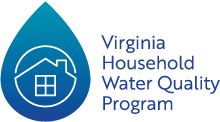Program Resources
Water Testing Links
- Virginia Certified Private Water Quality Lab Listing
- Participating in a VAHWQP drinking water clinic? Sample collection video here!
Common Water Quality Issues
- New! Safeguarding Your Well & Septic System Against Flooding Hazards
- New! PFAS in drinking water and private wells
- New! Disaster Preparedness and Response for Wells and Septics Webinar (Dec 3, 2024)
- What to know when buying a home with a well and septic system video (made in collaboration with Virginia Department of Health)
- New! Ten Tips for Managing Your Private Water Supply Infographic
- Recorded results interpretation meeting presentation
- VAHWQP contaminants interpretation sheet
- Household Water Treatment
- Indicators of Lead in Household Water
- Fluoride in Drinking Water Infographic (HTML)
- Bacteria and Microorganisms in Household Water
- Hardness in Household Water
- Shock Chlorination: Disinfecting Private Household Water Supply Systems
- Total Dissolved Solids (TDS) in Household Water
- Sulfate and Hydrogen Sulfide in Household Water
- Nitrate in Household Water
- Heavy Metals in Household Water
- Iron and Manganese in Household Water
- Fluoride in Household Water
- Sodium and Chloride in Household Water
- Corrosive Household Water
- Emergency Supplies of Water
- Helpful Shock Chlorination Video from Montana State University
- Managing Your Well During a Drought
- Sanitary Well Caps and Grouting
- Using a Low-yielding Well
- Radon in Household Water
- NEW! What happens if my septic system fails?
- NEW! Septic system best management practices
Financial Assistance
- Southeast Rural Community Assistance Project in Virginia (SERCAP) - promotes the development of affordable water and wastewater facilities, activities and resources to improve the quality of life for low income rural residents
- Virginia Department of Health Septic and Well Assistance Program - You may qualify to have your private well or septic system fixed for free! If you have a house with a well or septic system that needs to be fixed, and your income is at or below 200% of the federal poverty guidelines, VDH can cover the cost!
- USDA Rural Development Programs - housing, emergency, and community development grants
- Virginia Department of Housing and Community Development
Springs and Cistern Resources
VAHWQP Infographics
Popular Press and Journal Articles
- What to know when buying a home with a well and septic system video (made in collaboration with Virginia Department of Health)
- NEW! Virginia Household Water Quality Program featured on First Fridays with Hermon Maclin! Building Local Relationships and Attracting New Clients to VCE
- PFAS in Drinking Water - June 2022 Webinar
- FEATURED! Well Maintenance, Ground and Surface Water, and Well Drilling on Pulse of the Planet!
- Human and Agricultural Biosciences Building (home of BSE Water Quality Lab) featured on NPR!
- Peer-reviewed journal articles relating to VAHWQP:
- Allevi, et al., 2013. Quantitative analysis of microbial contamination in private drinking water supply systems. Journal of Water and Health 11.2 pp 244-255. doi: 10.2166/wh.2013.152.
- Benham, et al., 2016. What's in your water? Development and Evaluation of the Virginia Household Water Quality Program and Virginia Master Well Owner Network. Journal of Human Sciences and Extension. Volume 4, Number 1. pp 123-138.
- Fields, N. I., Shaffer, T. (2022). An Introduction to Environmental Justice and Extension Programs Engaging Vulnerable Communities. In N. I. Fields, & T. Shaffer (Eds.), Striving for Grassroots Engagement: Community Education, Social Justice, Cultural Competence, and the Role of Cooperative Extension. Michigan State University Press. 2022.
- Fasaee, M., Pesantez, J., Pieper, K., Ling, E., Benham, B., Edwards, M., and Berglund, E. Developing Early Warning Systems to Predict Water Lead Levels in Tap Water for Private Systems, Water Research.Vol 221. August 2022.
- Fasaee, M., Berglund, E., Pieper, K., Ling, E., Benham, B., and Edwards, M. Using Bayesian Belief Models and Machine Learning to Predict Water Lead Levels in Tap Water for Private Systems, Water Research. Vol 189. Feb 2021.
- Hinkle, M.A.G., Ziegler, B., Culbertson, H. et al. Manganese exposure from spring and well waters in the Shenandoah Valley: interplay of aquifer lithology, soil composition, and redox conditions. Environ Geochem Health 46, 203 (2024). https://doi.org/10.1007/s10653-024-01987-4
- Hohweiler, K., L. Krometis, E. Ling, K. Xia. 2024. "Incidence of per-and polyfluoroalkyl substances (PFAS) in private drinking water supplies in Southwest Virginia, USA ." Science of the Total Environment. doi:10.1016/j.scitotenv.2024.172539
- Patton. H., L. Krometis, E.Ling, A. Cohen, E. Sarver, 2024. "Faucet-mounted point-of-use drinking water filters to improve water quality in households served by private wells". Science of The Total Environment, Volume 906, 167252, ISSN 0048-9697, https://doi.org/10.1016/j.scitotenv.2023.167252.
- Patton, H., Krometis, L.-A., Faulkner, B.B., Cohen, A., Ling, E. and Sarver, E. (2023), Developing a Simple Strategy for Roadside Spring Water Disinfection in Central Appalachia. Journal of Contemporary Water Research & Education, 178: 1-16. https://doi.org/10.1111/j.1936-704X.2023.3388.x
- Pieper, et al., 2015. Profiling Private Water Systems to Identify Patterns of Waterborne Lead Exposure. Environmental Science and Technology. DOI: 10.1021/acs.est.5b03174
Environ. Sci. Technol. 2015, 49, 1269712704. - Pieper, et al., 2015. Incidence of waterborne lead in private drinking water systems in Virginia. Journal of Water and Health 13.3. pp 897-908. doi: 10.2166/wh.2015.275.
- Pieper et al. 2016. Quantifying lead leaching potential from plumbing exposed to aggressive waters. Journal-American Water Works Association 108 (9), E458-468.
- Pieper et al. 2016. Simultaneous Influence of Geology and System Design on Drinking Water Quality in Private Systems. Journal of Environmental Health 79 (2), E1-E9.
- Scott, V.; Juran, L.; Ling, E.J.; Benham, B.; Spiller, A. Assessing Strontium and Vulnerability to Strontium in Private Drinking Water Systems in Virginia. Water 2020, 12, 1053.
- Smith, et al., 2014. Associations between fecal indicator bacteria prevalence and demographic data in private water supplies in Virginia. Journal of Water and Health 12.4 pp 824-834. doi: 10.2166/wh.2014.026.
- VanDerwerker, T., Zhang, L., Ling, E., Benham, B., and Schreiber, 2018. Evaluating Geologic Sources of Arsenic in Well Water in Virginia (USA). Int. J. Environ. Res. Public Health 2018, 15, 787; doi:10.3390/ijerph15040787.
Water Conservation and Rainwater Harvesting
Partners in Well Education
- Virginia Department of Health - Private Well Program
- Virginia Water Well Association
- Virginia Department of Environmental Quality Groundwater Characterization
- EPA Private Wells
- National Sanitation Foundation- list of certified water treatment devices
- Water Quality Association
- United States Geological Survey - Virginia



